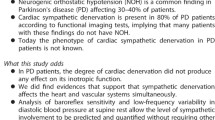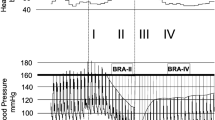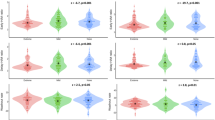Abstract
Left ventricular (LV) function was continuously monitored using a radionuclide detector (VEST) after intravenous injection of 25 mCi technetium-99m labelled red blood cells in nine patients with Parkinson's disease and postural hypotension (group 1) and ten patients with Parkinson's disease but without postural hypotension (group 2). LV function and blood pressure were monitored in the supine position for 15 min (period A), upon changing posture from the supine to the upright position for 10 min (period B), and upon returning to the supine position for 10 min (period C). In group 1, the passage from period A to period B induced a significant decrease in end-diastolic volume, end-systolic volume and ejection fraction (allP<0.01). In group 2, ejection fraction increased (P<0.05) upon changing posture from the supine to the upright position. Ejection fraction (F=33,P<0.01), end-diastolic volume (F=9,P<0.05) and end-systolic volume (F=10,P<0.05) were significantly different between the two groups. In group 1, stroke volume, cardiac output and vascular peripheral resistance decreased from period A to period B (allP<0.001). In group 2, no changes in stroke volume, cardiac output and vascular peripheral resistance were observed from period A to period B. All parameters were similar in the two groups during the periods A and C. Upon changing posture from the supine to the upright position, patients with Parkinson's disease and postural hypotension showed marked changes in parameters of LV function induced by vascular abnormalities. The results of this study may help to clarify the potential risk of sudden postural changes in such patients, which may cause fainting, syncope and increased risk of ischaemic coronary and cerebrovascular attacks and of lower limb fractures.
Similar content being viewed by others
References
Rajput AH, Rozdilsky B. Dysautonomia in parkinsonism: a clinicopathological study.J Neural Neurosurg Psychiatry 1976; 39: 1092–1100.
Aminoff MJ, Wilcox CS. Assessment of autonomic function in patients with parkinsonian syndrome.Br Med J 1971; 4: 80–84.
Barbeau A, Gillo-Joffroy L, Boucher R, Nowaczynski W, Genest J. Renin-aldosterone system in Parkinson's disease.Science 1969; 165: 291–296.
Calne DB, Brennan J, Spiers ASD, Stern GM. Hypotension caused byL-Dopa.Br Med J 1970; 1: 474–475.
Oliver DJ. Heart rate response to standing as a test for autonomic neuropathy.Br Med J 1978; 1: 1349–1350.
Fox RH. The controlled-hypertermia heat tolerance test. In: Werner JS, Lourie JA, eds. Human biology. A guide to field methods. Oxford: Blackwell; 1969: 359–376.
Collins KJ, Saxton-Smith AN, James MH, Oliver DJ. Functional changes in autonomic nervous responses with ageing.Age Ageing 1980; 9: 17–24.
Pagani M, Lombardi F, Guzzetti S, Rimoldi O, Furlan R, Pizzinelli P, Malliani A. Power spectral analysis of heart rate and arterial pressure variabilities as a marker of sympathovagal interaction in man and in conscious dog.Circ Res 1986; 59: 178–193.
Wilson RA, Sullivan PJ, Moore RH, et al. An ambulatory ventricular function monitor: validation and preliminary results.Am J Cardiol 1983; 52: 601–606.
Pace L, Cuocolo A, Nappi A, Nicolai E, Trimarco B, Salvatore M. Accuracy and repeatability of left ventricular systolic and diastolic function measurements using an ambulatory radionuclide monitor.Eur J Nucl Med 1992; 19: 800–806.
Bairey CN, De Yang L, Berman DS, Rozanski A. Comparison of physiologic ejection fraction responses to activities of daily living: implications for clinical testing.J Am Coll Cardiol 1990; 6: 847–854.
De Yang L, Bairey CN, Berman D, Nichols KJ, Odom-Mayron T, Rozanski A. Accuracy and reproducibility of left ventricular ejection fraction measurements using an ambulatory radionuclide left ventricular function monitoring.J Nucl Med 1991; 32: 796–802.
Cuocolo A, Nappi A, Nicolai E, et al. Ambulatory monitoring of left ventricular function: evaluation of transient left ventricular dysfunction in patients with coronary artery disease.G Ital Cardiol 1992; 22: 813–834.
Kiess MC, Dimsdale JE, Moore RH, et al. The effects of stress on left ventricular ejection fraction.Eur J Nucl Med 1988; 14: 12–16.
Tamaki N, Yasuda T, Moore RA, et al. Continuous monitoring of left ventricular function by an ambulatory radionuclide detector in patients with coronary artery disease.J Am Coll Cardiol 1988; 12: 669–679.
Kayden DS, Wackers FJT, Zaret BL. Silent left ventricular dysfunction during routine activity after thrombolytic therapy for acute myocardial infarction.J Am Coll Cardiol 1990; 14: 1500–1507.
Myers MG, Kearns PM, Kennedy DS, Fisher RH. Postural hypotension and diuretic therapy in the elderly.Can Med Assoc J 1978; 119: 581–584.
Mader SL, Josephson KR, Rubistein LZ. Low prevalence of postural hypotension among community-dwelling elderly.JAMA 1987; 258: 1511–1514.
Caird FI, Andrews GR, Kennedy RD. Effect of posture on blood pressure in the elderly.Br Heart J 1973; 35: 527–530.
Mac Lennon WJ, Hall MR, Timothy JL. Postural hypotension in old age: is it disorder of the nervous system or of blood vessel?Age Ageing 1980; 12: 25–32.
Ferrara LA, Cicerano U, Marotta T, et al. Postprandial and postural hypotension in the elderly.Cardiol Elderly 1993; 1: 33–37.
Eckberg DI. Parasympathetic cardiovascular control in human disease: a critical review of methods and results.Am J Physiol 1980; 239: H581-H593.
Imbriaco M, Cuocolo A, Pace L, et al. Repeatability of haemodynamic responses to cardiac stimulations by ambulatory monitoring of left ventricular function.J Nucl Biol Med 1993; 37: 238–244.
Author information
Authors and Affiliations
Rights and permissions
About this article
Cite this article
Nappi, A., Cuocolo, A., Iazzetta, N. et al. Ambulatory monitoring of left ventricular function in patients with Parkinson's disease and postural hypotension. Eur J Nucl Med 21, 1312–1317 (1994). https://doi.org/10.1007/BF02426695
Received:
Revised:
Issue Date:
DOI: https://doi.org/10.1007/BF02426695




